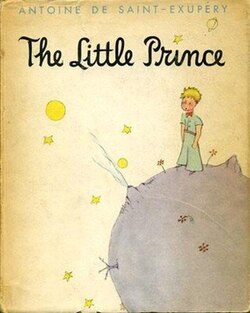The Little Prince is sometimes mistakenly viewed as a novel for children. Nothing could be farther from the truth.
It is a deeply personal and somewhat mysterious journey of the mind into the meaning of life, death, beauty and humanity.
I propose that we read this book together one chapter at a time and discuss it. It repays careful reading sublimely!
So, I'd ask that those of you who want to join this BOOK DISCUSSION find a copy (available easily and inexpensively) and read at least the first chapter in the next few days.
http://home.pacific.net.hk/~rebylee/text/prince/1.html
For the moment, we'll sort of bide our time by giving an overview of the author, his life and his relationship with the book's characters.
The following from SPARKNOTES:
B orn in Lyons, France, in 1900, Antoine de Saint-Exupéry considered himself a pilot above all else. For twenty years, he flew everything from cartography missions to commercial airlines, and flying occupied a significant place in his philosophical essays and fantasy writings. The theme of aviation was often Saint-Exupéry’s launching point for more abstract discussions on issues like the search for wisdom and the meaning of life.
Saint-Exupéry began writing The Little Prince during World War II, after Germany’s invasion of France had forced him to give up aviation and flee to New York. In addition to his torturous thoughts of the war in Europe, having to leave his homeland and no longer being able to fly planes affected Saint-Exupéry deeply. The novel’s nostalgia for childhood indicates both Saint-Exupéry’s homesick desire to return to France and his hope of returning to a time of peace. This wartime stress undoubtedly contributed to the sense of urgency in Saint-Exupéry’s message of love and compassion.
In its glorification of childlike innocence, The Little Prince is also an indictment of the spiritual decay Saint-Exupéry perceived in humanity. In 1943, he wrote, “For centuries, humanity has been descending an immense staircase whose top is hidden in the clouds and whose lowest steps are lost in a dark abyss. We could have ascended the staircase; instead we chose to descend it. Spiritual decay is terrible. . . . There is one problem and only one in the world: to revive in people some sense of spiritual meaning. . . .” By celebrating a worldview unsullied by the drab restrictions of adulthood, the novel attempts to revive a sense of spirituality in the world.
Some of the story of The Little Prince uses events taken from Saint-Exupéry’s own life. If the novel’s surreal fairy tale feels strangely real and personal, this effect is achieved, at least in part, by the fact that Saint-Exupéry was drawing from his own experiences. In Wind, Sand and Stars, his 1939 account of his aviation adventures, he recollects a crash landing he was forced to make in the Sahara desert. In his wanderings across the desert, Saint-Exupéry had a number of hallucinations, including an encounter with a fennec, a type of desert sand fox that bears a striking resemblance to the fox depicted in The Little Prince.
Saint-Exupéry may have seen himself in his characters of both the narrator and the little prince. Like his narrator, Saint-Exupéry was a pilot, crashed in the Sahara, and experienced there a kind of mystical revelation. The prince, however, represents aspects of Saint-Exupéry as well, and he very definitely embodies Saint-Exupéry’s philosophy and aspirations. The prince’s relationship with the rose could be a reflection of Saint-Exupéry’s relationship with his wife, and the prince is also an explorer and traveler of the skies—it is one of the first things that the prince and the narrator share in common. Seen in this light, The Little Prince can be read as a metaphor of the process of introspection itself, wherein two halves of the same person meet and learn from each other.
Although The Little Prince was undoubtedly influenced by the tenor of World War II, Saint-Exupéry aims for a general, apolitical analysis of human nature. The prevalence of symbols of death and evil in The Little Prince are often interpreted as references to Nazi Germany, but the book’s universally applicable fairy-tale symbols and the emblems of World War II make an awkward match. The Little Prince builds on a long tradition of French parables and fantasy literature, most notably expressed in Voltaire’s Candide. Like Voltaire, Saint-Exupéry urges his readers to participate actively in the reading process, using their imaginations to assign deeper meaning to deceptively simple prose and poetry. Saint-Exupéry and his novel were certainly affected by the historical events of the time, but The Little Prince aspires to be a universal and timeless allegory about the importance of innocence and love. Indeed, since it was first published, The Little Prince has become one of the most widely translated books in the history of French literature.

 The Little Prince - Links and online versions
The Little Prince - Links and online versions